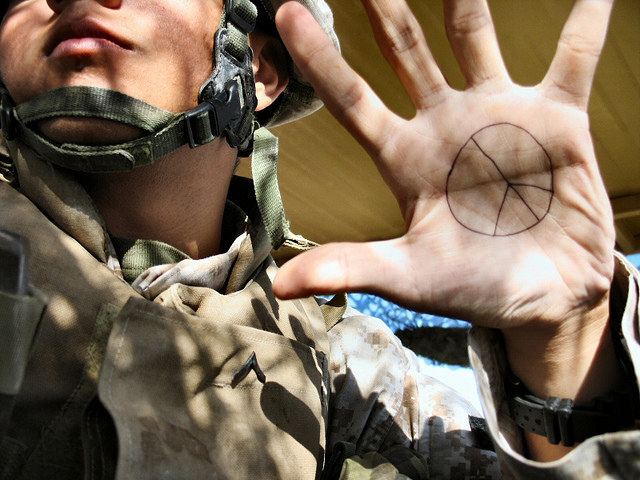Women, Peace and Security: a century-long battle for peace
Posted By Jenny Lee on March 10, 2017 @ 12:30

This article is part of a series on ‘Women, Peace and Security’ that The Strategist is publishing in recognition of International Women’s Day 2017.
For over a century, the international women’s civil society movement has advocated for the conviction that lies at the heart of United Nations Security Council Resolution 1325: that peace is only sustainable if women are fully included, and that peace is inextricably linked with equality and collaboration of men and women.
Ever since 1915, when 1,200 women met at The Hague [1] to discuss proposals to end World War One, the Women, Peace and Security Agenda has been a symbol of solidarity, tenacity and partnership at the international, regional and national levels. Australia has taken a leadership role on the WPS Agenda in our region. The Australian National Action Plan on Women, Peace and Security 2012–2018 [2] (NAP) is the first outward-looking NAP in the Asia–Pacific, which focuses on work in conflict-affected countries. This NAP also shares a journey of collaboration and open discussions with civil society. As a result of these discussions, shadow report cards are written to inform the government about gaps in the implementation of the NAP.
There are “push-backs” from men and women. Most are due to the limited understanding of the context and essence of the Agenda or a perspective that these principles are only relevant to those in conflict zones. A common assumption is that this Agenda is restricted to addressing “women’s issues” advocated by women. For organisations such as the military or the police, the ‘practical application’ of the Agenda isn’t always apparent at first glance and therefore it’s hard to conceptualise what this looks like on the ground.
Australia has made positive progress as a result of these push-backs. We have seen the ADF ‘test and adjust’ the Agenda in the operational planning process. We saw this in Exercise Talisman Sabre 15 where it was the first time that UNSCR 1325 was integrated into a major combined exercise, helping to build understanding of how the military can operationalise WPS. Operation Fiji Assist showed that the ADF has adopted a growing awareness and understanding of women’s unique experiences and contributions in humanitarian assistance and disaster response as part of whole-of government response. DFAT’s tremendous work in promulgating the Agenda in our region through series of excellent programs is also a good example.
The challenge for the unconverted is seeing these positive changes because they are subtle, and not immediate. It takes many years to benefit from the Agenda and this is true not only for beneficiaries in conflict or post-conflict areas, but for us in Australia. The difference is, in Australia we can discuss and debate the Agenda’s relevance and importance, and how it’s applied in a non-conflict context. This is a vital contribution to our region.
These opportunities and solutions can always be shared. This doesn’t mean dictating Australia’s solution to our regional partners, but is reciprocal learning of how the Agenda is interpreted and applied in different environments, cultures and norms.
The ACMC was fortunate to experience some of the positive outcomes of the Agenda first hand. We found that Australia’s approach to the constant consultative process with civil society was unique. Australia shared the journey of our NAP at the Asia-Pacific Regional Symposium on National Action Plans on Women, Peace and Security [3] in Bangkok last year, highlighting the important role of civil society in monitoring and sharing best practices and lessons learned. The Australian civil society report card was shared amongst colleagues who were present from the region, and there was a collective expression of praise for Australia.
Domestically, we saw the value of sharing knowledge through our own WPS workshops. We learned that members of different government agencies and civil society have much to share through discussions, application methodologies and thinking. As with all civilian-military-police engagements, many return to their agencies understanding the importance of the Agenda. We have also seen similar experiences with international engagements. The International Policy Division-run WPS workshop between TNI and ADF last year contributed to preparations for the Australia-Indonesia co-chairing of the ASEAN Defence Ministers Meeting-Plus Experts Working Group Meeting on Peacekeeping Operations, which commences this year. This workshop indicated that Australia isn’t only willing to learn from regional nations, but is open to sharing ideas and solutions.
There is much work to be done to pursue implementation of the WPS Agenda in our region and we are in a special position to do this through engagement and collaboration with our partners. Not simply for the sake of pursuing the WPS Agenda, but in pursuit of durable solutions in our region through effective regional civilian-military-police engagement with the collaboration of civil society.
The WPS Agenda is a tool that may pave the way for that change.
Article printed from The Strategist: https://www.aspistrategist.org.au
URL to article: https://www.aspistrategist.org.au/century-long-battle-peace/
URLs in this post:
[1] The Hague: https://archive.org/details/internatcongrewom00interich
[2] National Action Plan on Women, Peace and Security 2012–2018: https://www.dpmc.gov.au/office-women/international-forums/australian-national-action-plan-women-peace-and-security-2012%E2%80%932018
[3] Asia-Pacific Regional Symposium on National Action Plans on Women, Peace and Security: http://asiapacific.unwomen.org/en/digital-library/publications/2016/12/nap-report
Click here to print.